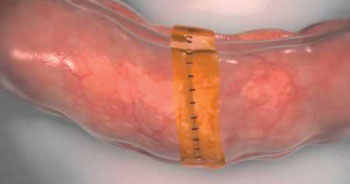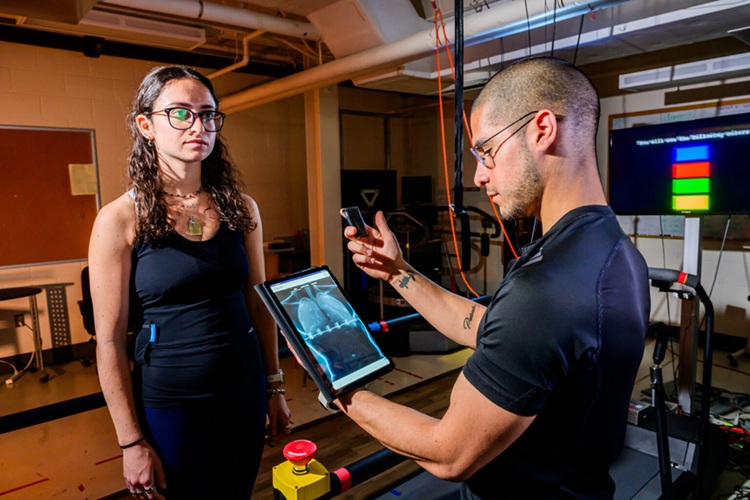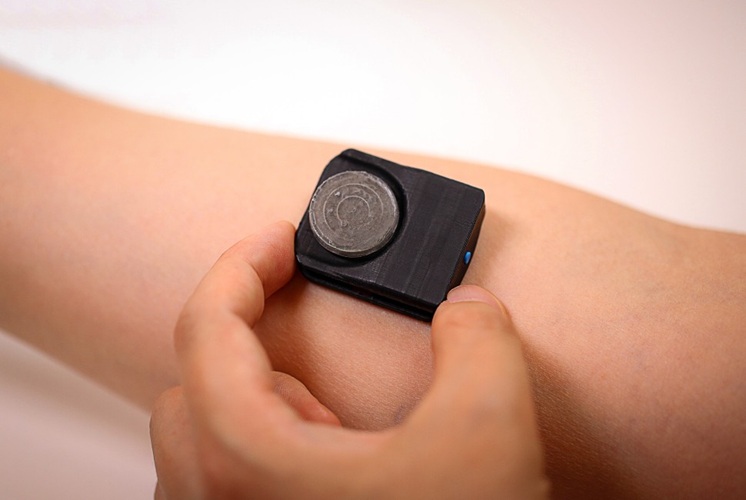Elastic Sealant Protects Suture Line After Gastro Surgery 
|
By HospiMedica International staff writers Posted on 30 Aug 2015 |

Image: Sylys Surgical Sealant placed over an anastomosis staple line (Photo courtesy of Cohera Medical).
A novel synthetic sealant has been specifically designed to help reduce leaks after gastrointestinal (GI) anastomosis procedures.
Sylys Surgical Sealant helps reduce anastomotic leakage in GI procedures by providing additional support to the anastomosis during the first few days of healing, when the development of leaks is most likely to occur. The elastic, resorbable, synthetic sealant protects the suture or staple line used in standard anastomotic closure techniques, supporting the anastomosis during the first few days of healing when leaks are most likely to occur. The rapid curing, single-part sealant provides good adherence to tissue, creating a flexible, elastic seal over the anastomosis site.
The curing process is initiated by contact of the viscous fluid with the moisture in the tissue. The cured sealant forms a network of large polymeric chains that allows it to remain soft and flexible, while also creating a strong tissue bond. The sealant remains well adhered to the tissue during the first two weeks after surgery, and then proceeds to break down into harmless subcomponents over a period of three months. Burst strength testing of the product shows that it is able to withstand pressures over 150 mmHg, twice that of normal bowel peristalsis. Sylys Surgical Sealant is a product of Cohera Medical (Pittsburg, PA, USA), and has received the European Community CE marking of approval.
“Sylys enhances standard closure techniques, advancing the healing process and reducing postoperative complications,” said Patrick Daly, President and CEO of Cohera Medical. “We are a step closer to providing patients with the best opportunity for a successful outcome following intestinal anastomosis procedures.”
“Anastomotic leak is the most devastating complication associated with intestinal resection, contributing to morbidity and mortality,” said James McCormick, DO, program director for general surgery at Forbes Hospital (Monroeville, PA, USA). “We have made tremendous strides in curtailing the risk associated with intestinal anastomosis, but we are always striving for further improvement and greater patient safety.”
Anastomotic leakage rates following colon resection range on average from 3%–15%. Such leakage is considered the most serious complication of bowel repair, doubling the length of stay and increasing mortality rates as much as ten-fold, with at least one third of the post-surgical mortality after colorectal surgery is attributed to leaks. Beyond the initial mortality risk, reoperation rates after leakage can be as high as 87%, and overall five year survival rates are reduced by 20%.
Related Links:
Cohera Medical
Sylys Surgical Sealant helps reduce anastomotic leakage in GI procedures by providing additional support to the anastomosis during the first few days of healing, when the development of leaks is most likely to occur. The elastic, resorbable, synthetic sealant protects the suture or staple line used in standard anastomotic closure techniques, supporting the anastomosis during the first few days of healing when leaks are most likely to occur. The rapid curing, single-part sealant provides good adherence to tissue, creating a flexible, elastic seal over the anastomosis site.
The curing process is initiated by contact of the viscous fluid with the moisture in the tissue. The cured sealant forms a network of large polymeric chains that allows it to remain soft and flexible, while also creating a strong tissue bond. The sealant remains well adhered to the tissue during the first two weeks after surgery, and then proceeds to break down into harmless subcomponents over a period of three months. Burst strength testing of the product shows that it is able to withstand pressures over 150 mmHg, twice that of normal bowel peristalsis. Sylys Surgical Sealant is a product of Cohera Medical (Pittsburg, PA, USA), and has received the European Community CE marking of approval.
“Sylys enhances standard closure techniques, advancing the healing process and reducing postoperative complications,” said Patrick Daly, President and CEO of Cohera Medical. “We are a step closer to providing patients with the best opportunity for a successful outcome following intestinal anastomosis procedures.”
“Anastomotic leak is the most devastating complication associated with intestinal resection, contributing to morbidity and mortality,” said James McCormick, DO, program director for general surgery at Forbes Hospital (Monroeville, PA, USA). “We have made tremendous strides in curtailing the risk associated with intestinal anastomosis, but we are always striving for further improvement and greater patient safety.”
Anastomotic leakage rates following colon resection range on average from 3%–15%. Such leakage is considered the most serious complication of bowel repair, doubling the length of stay and increasing mortality rates as much as ten-fold, with at least one third of the post-surgical mortality after colorectal surgery is attributed to leaks. Beyond the initial mortality risk, reoperation rates after leakage can be as high as 87%, and overall five year survival rates are reduced by 20%.
Related Links:
Cohera Medical
Latest Surgical Techniques News
- Intravascular Imaging for Guiding Stent Implantation Ensures Safer Stenting Procedures
- World's First AI Surgical Guidance Platform Allows Surgeons to Measure Success in Real-Time
- AI-Generated Synthetic Scarred Hearts Aid Atrial Fibrillation Treatment
- New Class of Bioadhesives to Connect Human Tissues to Long-Term Medical Implants
- New Transcatheter Valve Found Safe and Effective for Treating Aortic Regurgitation
- Minimally Invasive Valve Repair Reduces Hospitalizations in Severe Tricuspid Regurgitation Patients
- Tiny Robotic Tools Powered by Magnetic Fields to Enable Minimally Invasive Brain Surgery
- Magnetic Tweezers Make Robotic Surgery Safer and More Precise
- AI-Powered Surgical Planning Tool Improves Pre-Op Planning
- Novel Sensing System Restores Missing Sense of Touch in Minimally Invasive Surgery
- Headset-Based AR Navigation System Improves EVD Placement
- Higher Electrode Density Improves Epilepsy Surgery by Pinpointing Where Seizures Begin
- Open-Source Tool Optimizes Placement of Visual Brain Implants
- Easy-To-Apply Gel Could Prevent Formation of Post-Surgical Abdominal Adhesions
- Groundbreaking Leadless Pacemaker to Prevent Invasive Surgeries for Children
- Spectroscopy Technique Improves Surgery for Pediatric Epilepsy Patients
Channels
Critical Care
view channel
Novel Intrabronchial Method Delivers Cell Therapies in Critically Ill Patients on External Lung Support
Until now, administering cell therapies to patients on extracorporeal membrane oxygenation (ECMO)—a life-support system typically used for severe lung failure—has been nearly impossible.... Read more
Generative AI Technology Detects Heart Disease Earlier Than Conventional Methods
Detecting heart dysfunction early using cost-effective and widely accessible tools like electrocardiograms (ECGs) and efficiently directing the right patients for more expensive imaging tests remains a... Read more
Wearable Technology Predicts Cardiovascular Risk by Continuously Monitoring Heart Rate Recovery
The heart's response to physical activity is a vital early indicator of changes in health, particularly in cardiovascular function and mortality. Extensive research has demonstrated a connection between... Read more
Wearable Health Monitoring Device Measures Gases Emitted from and Absorbed by Skin
The skin plays a vital role in protecting our body from external elements. A key component of this protective function is the skin barrier, which consists of tightly woven proteins and fats that help retain... Read morePatient Care
view channel
Portable Biosensor Platform to Reduce Hospital-Acquired Infections
Approximately 4 million patients in the European Union acquire healthcare-associated infections (HAIs) or nosocomial infections each year, with around 37,000 deaths directly resulting from these infections,... Read moreFirst-Of-Its-Kind Portable Germicidal Light Technology Disinfects High-Touch Clinical Surfaces in Seconds
Reducing healthcare-acquired infections (HAIs) remains a pressing issue within global healthcare systems. In the United States alone, 1.7 million patients contract HAIs annually, leading to approximately... Read more
Surgical Capacity Optimization Solution Helps Hospitals Boost OR Utilization
An innovative solution has the capability to transform surgical capacity utilization by targeting the root cause of surgical block time inefficiencies. Fujitsu Limited’s (Tokyo, Japan) Surgical Capacity... Read more
Game-Changing Innovation in Surgical Instrument Sterilization Significantly Improves OR Throughput
A groundbreaking innovation enables hospitals to significantly improve instrument processing time and throughput in operating rooms (ORs) and sterile processing departments. Turbett Surgical, Inc.... Read moreHealth IT
view channel
Printable Molecule-Selective Nanoparticles Enable Mass Production of Wearable Biosensors
The future of medicine is likely to focus on the personalization of healthcare—understanding exactly what an individual requires and delivering the appropriate combination of nutrients, metabolites, and... Read more
Smartwatches Could Detect Congestive Heart Failure
Diagnosing congestive heart failure (CHF) typically requires expensive and time-consuming imaging techniques like echocardiography, also known as cardiac ultrasound. Previously, detecting CHF by analyzing... Read moreBusiness
view channel
Expanded Collaboration to Transform OR Technology Through AI and Automation
The expansion of an existing collaboration between three leading companies aims to develop artificial intelligence (AI)-driven solutions for smart operating rooms with sophisticated monitoring and automation.... Read more















